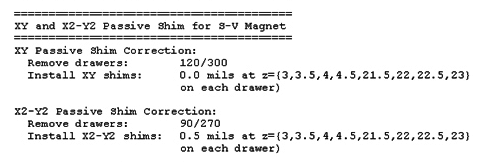Passive shimming is a method of field correction involving the use of ferromagnetic materials, typically iron or steel, placed in a regular pattern at specific locations along the inner bore of the magnet.
|
The most common design for cylindrical superconducting scanners involves the use of 12-24 trays arranged symmetrically around the circumference of the magnet. Each tray slides along the z-axis of the scanner and contains pockets into which a desired number of ferromagnetic shim elements can be placed.
|
|
The specific trays, slots, number, and size of shim elements to be inserted are determined by specialized shimming software used during the magnetic field mapping process (actual computer printout below). Field mapping is then repeated and the shims tweaked or adjusted as needed. Several iterations of this process may be required until the desired level of homogeneity is reached.
|
By careful passive shimming excellent static homogeneity of the main magnetic field may be achieved. A disadvantage of this technique is that the shim material is temperature sensitive, and when the bore heats (as it commonly does with gradient-intensive sequences), field shifts may occur. Additionally, the shims may become magnetized over time, requiring replacement and/or repositioning.
An even more significant limitation of passive shimming lies in the fact that it is a static solution created for an empty magnet. When a patient is placed within the scanner, additional field distortions result from diamagnetic susceptibility effects. Each patient therefore creates a unique pattern of inhomogeneity that can only be corrected through a dynamic process. Active shimming provides a method to correct for these individual variations in field from patient to patient.
An even more significant limitation of passive shimming lies in the fact that it is a static solution created for an empty magnet. When a patient is placed within the scanner, additional field distortions result from diamagnetic susceptibility effects. Each patient therefore creates a unique pattern of inhomogeneity that can only be corrected through a dynamic process. Active shimming provides a method to correct for these individual variations in field from patient to patient.
Advanced Discussion (show/hide)»
No supplementary material yet. Check back soon!
References
Jezzard P. Shim coil design, limitations and implications (pdf). Abstracts from the International Society of Magnetic Resonance in Medicine (ISMRM) Annual Meeting, May, 2006.
Jezzard P. Shim coil design, limitations and implications (pdf). Abstracts from the International Society of Magnetic Resonance in Medicine (ISMRM) Annual Meeting, May, 2006.
Related Questions
What can you do to make a magnetic field more homogeneous?
How is active shimming performed?
What is magnetic susceptibility?
What can you do to make a magnetic field more homogeneous?
How is active shimming performed?
What is magnetic susceptibility?




